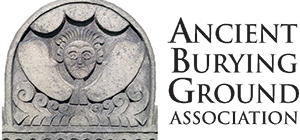The physical gravestone can often say as much about the person it commemorates and their world as do any words carved into it. The size, design, and images of a gravestone all convey powerful, if silent, messages.
Who had a gravestone and why?
Approximately 422 headstones and 169 footstones remain at the Ancient Burying Ground. Many graves, especially of the well-to-do, were marked with both a headstone, which bore the epitaph, and at the opposite end a smaller, plainer footstone, which might bear the deceased’s initials or decorative carving.
Few if any gravestones were erected in the earliest years of the burying ground. The first generations of Puritan settlers considered grave markers a remnant of the ornamentation of the Church of England, which they sought to purify. And a frontier community like Hartford had little need for the talent of carving gravestones.
Gravestones, even plain ones, were expensive luxury items during the two centuries the Ancient Burying Ground was in use. It’s been estimated that only one out of 10 people who died during this period had a marker erected over their grave. The simple presence of a gravestone indicates that the deceased person was prosperous or influential or was important to someone who was.
The Makers of the Markers: A Walking Tour of Colonial Stonecutter Art Brochure (below) identifies some of the carvers whose work can be seen at the Ancient Burying Ground.
